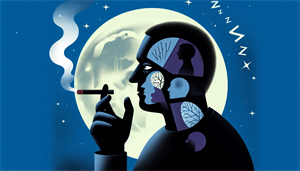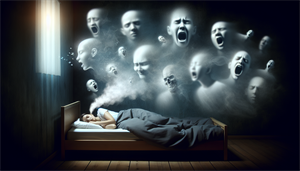Are you searching for clarity on the types of sleep apnea? Discover the essential differences between obstructive, central, and complex sleep apnea syndrome - the three main types that can disrupt rest and health.
This article offers a concise overview, setting the stage for a deeper dive into each type’s features and management strategies.
Key Takeaways
-
There are three types of sleep apnea: Obstructive (OSA), Central (CSA), and Complex Sleep Apnea Syndrome (CompSAS), each with distinct causes and treatments.
-
Severity of Obstructive Sleep Apnea is categorized into mild, moderate, and severe based on the Apnea-Hypopnea Index (AHI), necessitating different levels of intervention.
-
Effective treatment for sleep apnea can include Continuous Positive Airway Pressure (CPAP) therapy, lifestyle changes, behavioral therapy, and, in severe cases, surgical intervention.
Understanding Sleep Apnea: Types and Causes

How is sleep apnea affecting individuals? This disorder, characterized by intermittent breathing pauses during sleep, can negatively impact sleep quality and contribute to various health problems. The condition extends beyond simple inconvenience, posing potential health risks that require accurate treatment and a commitment to a healthy lifestyle.
There are three categories of sleep apnea:
-
Obstructive sleep apnea (OSA): This type is caused by physical obstructions in the airway that trigger breathing interruptions while sleeping.
-
Central sleep apnea (CSA): CSA results from a disconnect between the brain and respiratory muscles, leading to breathing interruptions during sleep.
-
Complex sleep apnea syndrome (CompSAS): CompSAS combines elements of both OSA and CSA.
Each type arises from distinct factors and requires different treatment approaches.
Obstructive Sleep Apnea (OSA)
Obstructive Sleep Apnea, known as OSA, is the prevailing form of sleep apnea, resulting from a physical obstruction in the airway during sleep. This obstruction commonly arises from relaxed throat muscles or surplus tissue impeding the airflow. Obstructive sleep apnea occurs when these obstructions lead to insufficient oxygen intake and multiple sleep disruptions throughout the night. It is crucial to have obstructive sleep apnea diagnosed to ensure proper treatment and management.
This can result in snoring, gasping, and choking, making a full night’s sleep almost impossible.
Central Sleep Apnea (CSA)
On the other hand, Central Sleep Apnea occurs due to a malfunction in the brain stem’s ability to accurately detect carbon dioxide levels in the body while sleeping. Unlike OSA, the prevalence of central sleep apnea is relatively low, estimated to affect fewer than 1% of people. Although less common, CSA is equally crucial to diagnose and treat due to its potential health implications.
Complex Sleep Apnea Syndrome (CompSAS)
Complex sleep apnea syndrome, as the name suggests, is complex in nature and necessitates a comprehensive treatment approach. It is characterized by a combination of both obstructive and central sleep apnea, making its management slightly more challenging.
The indicators of CompSAS are akin to those of OSA and encompass snoring, choking, gasping, and restless sleep.
Mild, Moderate and Severe Obstructive Sleep Apnea

Obstructive Sleep Apnea can occur with varying severity, classified into mild, moderate, and severe. The severity is assessed based on the apnea-hypopnea index (AHI), which quantifies the frequency of apneas and hypopneas per hour of sleep. Thus, the frequency of breathing interruptions varies based on the severity of obstructive sleep apnea:
-
Mild sleep apnea: 5 to 14 interruptions per hour
-
Moderate sleep apnea: 15 to 29 interruptions per hour
-
Severe sleep apnea: more than 30 interruptions per hour
These numbers are more than just statistics; they represent the severity of a health condition that can significantly impact quality of life. Thus, understanding the severity of OSA is fundamental, as it can guide the appropriate treatment plan and determine the urgency of intervention.
Mild OSA
Mild OSA, identified by an Apnea-Hypopnea Index (AHI) of 5 to 14 events per hour, may not require extensive treatment. However, it should still be monitored due to its potential to deteriorate over time and develop into moderate or severe OSA.
The common indicators of mild OSA include loud snoring, episodes of stopped breathing during sleep, concentration troubles, decreased libido, and erectile dysfunction, among others.
Moderate OSA
In contrast, moderate OSA is characterized by an AHI of 15 to 29 events per hour and may require more aggressive treatment. The associated health implications encompass:
-
high blood pressure
-
heart disease
-
impaired driving
-
mental health changes
-
daytime fatigue and sleepiness
-
depression
-
anxiety
-
memory loss
-
trouble concentrating
-
cardiovascular complications
Severe OSA
Severe OSA is a serious medical condition, indicated by an AHI of 30 or more events per hour. It is associated with significant breathing interruptions and poses a higher risk for serious health issues, requiring immediate and comprehensive treatment.
The recommended immediate treatments for severe OSA typically include:
-
Continuous Positive Airway Pressure (CPAP) therapy
-
Weight loss and exercise
-
Avoidance of alcohol and sedating medications
-
Use of nasal sprays and adhesive strips
Risk Factors for Developing Sleep Apnea

Various risk factors that can enhance the chances of developing sleep apnea include:
-
Obesity
-
Sedentary lifestyle
-
Poor diet
-
Smoking
-
Excessive alcohol consumption
These lifestyle choices, along with certain health conditions and genetic predispositions, can amplify the risk of sleep apnea.
These risk factors can increase the likelihood of developing the disorder and, if not adequately addressed, can lead to a progression in the severity of the condition. Thus, controlling these risk factors is a key component in managing sleep apnea.
Lifestyle and Health Factors
Lifestyle and health factors such as obesity, smoking, alcohol consumption, and high blood pressure can significantly contribute to sleep apnea risk. For instance, obesity contributes to sleep apnea as excess body fat, especially around the neck and throat, can compress and obstruct the upper airway during sleep, resulting in apnea events.
Similarly, smoking is a substantial risk factor for sleep apnea. Research indicates that smokers are three times more susceptible to developing obstructive sleep apnea compared to non-smokers.
Genetic Factors
Genetic factors, including family history and inherited physical traits, can also play a role in sleep apnea development. Certain inherited physical traits and specific genes are believed to be linked to the development of sleep apnea. These genes play a role in bodily processes like muscular control and fat distribution, which can contribute to the onset of obstructive sleep apnea.
Recognizing Sleep Apnea Symptoms

Recognizing the symptoms of sleep apnea is a crucial step in managing the condition. These symptoms can manifest both during the night and affect daytime functioning. Nighttime symptoms encompass:
-
Excessive daytime sleepiness
-
Loud snoring
-
Observed episodes of stopped breathing during sleep
-
Waking during the night gasping or choking
The impact of sleep apnea on daytime functioning can’t be underestimated, leading to symptoms such as:
-
severe fatigue
-
daytime drowsiness
-
irritability
-
difficulty concentrating
-
morning headaches
-
depression and anxiety
-
frequent napping
-
unintentional falling asleep
Nighttime Symptoms
Nighttime symptoms of sleep apnea include:
-
Loud snoring
-
Episodes of stopped breathing during sleep
-
Waking during the night and gasping or choking
-
Restless sleep
These symptoms can be alarming not only for the person with the condition but also for their bed partner.
Daytime Symptoms
Daytime symptoms of sleep apnea include:
-
Severe fatigue
-
Daytime drowsiness
-
Irritability
-
Difficulty concentrating
-
Morning headaches
These symptoms can greatly impact daily life and productivity. The disruptive sleep patterns due to sleep apnea can lead to impairments in attention, memory, decision-making, and planning abilities.
Diagnosing Sleep Apnea

To diagnose sleep apnea, it is essential to consult with a sleep specialist who will evaluate symptoms, risk factors, and medical history to determine the need for further testing. An in-clinic sleep study is capable of identifying abnormal breathing patterns and distinguishing between obstructive and central sleep apnea, whereas an at-home sleep study is predominantly utilized for patients suspected of having more severe obstructive sleep apnea.
Polysomnography, widely regarded as the most reliable type of sleep study for diagnosing sleep apnea, comprehensively records various body functions during sleep. These recordings are evaluated by sleep specialists to ascertain the presence of sleep apnea or other sleep disorders.
Consultation with a Sleep Specialist
During a consultation with a sleep specialist, you can anticipate inquiries about your reasons for suspecting sleep apnea, your symptoms, and their impact on your daily life. A sleep specialist would typically evaluate symptoms such as snoring, breathing interruptions during sleep, morning headaches, daytime sleepiness, lack of concentration, and memory problems.
Sleep Studies
Sleep studies, particularly polysomnography, play a crucial role in the diagnosis of sleep apnea. Polysomnography captures a range of physiological parameters during sleep, such as:
-
brain waves
-
heart rate
-
breathing patterns
-
oxygen levels
These recordings are evaluated by sleep specialists to ascertain the presence of sleep apnea or other sleep disorders.
Treatment Options for Sleep Apnea
Fortunately, sleep apnea can be effectively treated. The type and severity of the disorder guide the selection of treatments to treat sleep apnea, which could range from CPAP therapy and lifestyle modifications to surgical interventions. While CPAP therapy is usually the go-to for moderate and severe cases, mild sleep apnea cases might benefit from alternative treatments like oral appliances.
The main treatment modalities employed for managing Obstructive Sleep Apnea include CPAP (Continuous Positive Airway Pressure) and PAP (Positive Airway Pressure) therapy, which have demonstrated effectiveness across a range of sleep apnea severities.
Continuous Positive Airway Pressure (CPAP)
Continuous Positive Airway Pressure (CPAP) therapy is a widely recognized treatment method involving the use of a machine to deliver a continuous flow of air, which helps prevent the collapse of the airway during sleep, effectively addressing sleep apnea.
Lifestyle Changes and Behavioral Therapies
Lifestyle changes and behavioral therapies that can help alleviate sleep apnea symptoms and improve overall health include:
-
Weight loss
-
Increased physical activity
-
Cessation of smoking
-
Limiting alcohol consumption
Surgical Interventions
For severe cases or when other treatments have failed, surgical interventions may be considered. These include:
-
Uvulopalatopharyngoplasty (UPPP)
-
Tongue-reduction techniques such as radiofrequency ablation (RFA)
-
Reduction glossectomy
-
Transoral robotic surgery
-
Tonsillectomies for adults with mild to moderate OSA
Coping with Sleep Apnea: Tips for Better Sleep
Managing sleep apnea extends beyond medical interventions. A comprehensive approach - encompassing healthy sleep habits and support from healthcare professionals, family, and friends - can significantly enhance sleep quality and overall well-being. Key sleep hygiene practices for those with sleep apnea involve adhering to a consistent sleep schedule, finding a comfortable sleep position, and avoiding heavy meals and stimulants close to bedtime.
Furthermore, support networks and resources, including sleep apnea support groups and educational materials, can provide valuable information and encouragement for those living with the disorder.
Sleep Hygiene Practices
Sleep hygiene practices such as maintaining a consistent sleep schedule and creating a comfortable sleep environment can help manage sleep apnea symptoms.
Maintaining a consistent sleep schedule contributes to the management of sleep apnea by regulating the body’s internal clock and promoting consistent, high-quality sleep.
Support Networks and Resources
Support networks can benefit individuals living with sleep apnea by offering:
-
Education and information
-
Emotional support
-
Practical tips and advice
-
Encouragement and motivation to effectively manage their condition
Summary
To summarize, sleep apnea is a common sleep disorder with three types, each caused by different factors. It can be mild, moderate, or severe and is associated with several risk factors. Recognizing the symptoms of sleep apnea, both nighttime and daytime, is essential for its management. Effective treatments include CPAP therapy, lifestyle changes, surgical interventions, and maintaining good sleep hygiene. Support networks and resources can provide valuable information and encouragement for those living with the disorder. Remember, a good night’s sleep is not a luxury; it’s a necessity for a healthy life.
Frequently Asked Questions
What are the 4 types of sleep apnea?
The four types of sleep apnea include obstructive, central, complex, and a fourth type known as mixed or complex sleep apnea. Each type has different causes and treatment options.
How can you tell the difference between central and obstructive sleep apnea?
Central sleep apnea occurs due to a lack of proper signals from the brain to control breathing, while obstructive sleep apnea is a result of the airway closing during sleep. Central sleep apnea is less common than obstructive sleep apnea.
Which type of sleep apnea is more common?
The most common type of sleep apnea is obstructive sleep apnea, which occurs when muscles at the back of the throat relax and obstruct the airway, interrupting breathing. It is more prevalent than central sleep apnea.
What is complex sleep apnea syndrome?
Complex sleep apnea syndrome, or CompSAS, is a distinct form of sleep-disordered breathing characterized by the presence of both central sleep apnea (CSA) and obstructive sleep apnea (OSA) during initial treatment with a continuous positive airway pressure (CPAP) device. It is a condition where central apneas or hypopneas persist or emerge with CPAP treatment despite the disappearance of obstructive events.
What is sleep apnea and why is it important to treat it?
Treating sleep apnea is important to maintain a healthy lifestyle and reduce the risk of chronic health problems caused by breathing interruptions during sleep.


